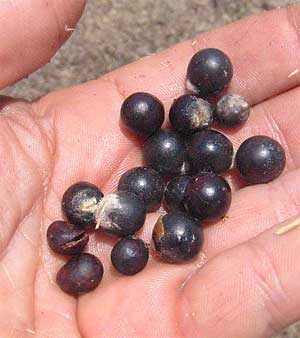Excerpts from Jim Conrad's
Naturalist Newsletter
from the June 23, 2013 Newsletter issued from the Frio Canyon Nature Education Center in the valley of the Dry Frio River in northern Uvalde County, southwestern Texas, on the southern border of the Edwards Plateau; elevation ~1750m (~5750 ft); N29.62°, W99.86°; USA
SOAPBERRY TREES FLOWERING
Now our Soapberry trees are producing broad, 10-inch long (25cm) panicles of tiny, white flowers, which display very handsomely against the trees' early summer dark green foliage, as shown below:
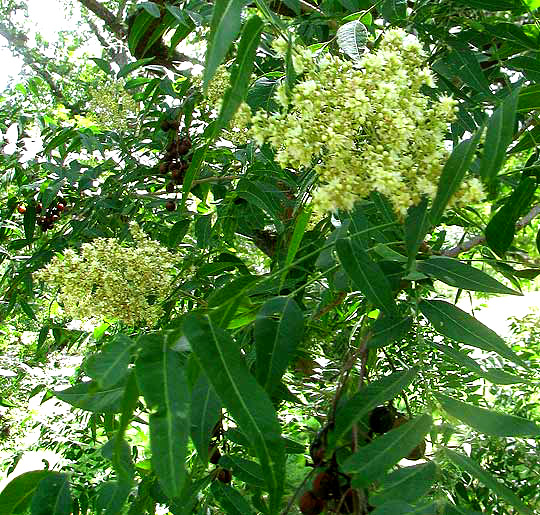
A close-up showing a single ¼-inch broad (7mm) Soapberry flower with its eight stamens -- an unusual stamen number for a five-petaled blossom -- with their hairy anthers appears below:
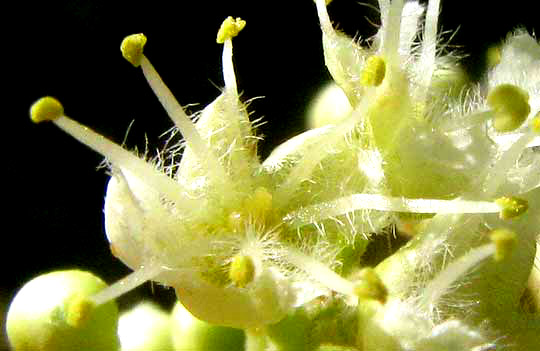
from the October 5, 2014 Newsletter issued from the Frio Canyon Nature Education Center in the valley of the Dry Frio River in northern Uvalde County, southwestern Texas, on the southern border of the Edwards Plateau; elevation ~1750m (~5750 ft); N29.62°, W99.86°; USA
SOAPBERRY'S SMALL-FRUIT STAGE
Nowadays Soapberry fruiting heads are filled with numerous small fruits, as seen below:
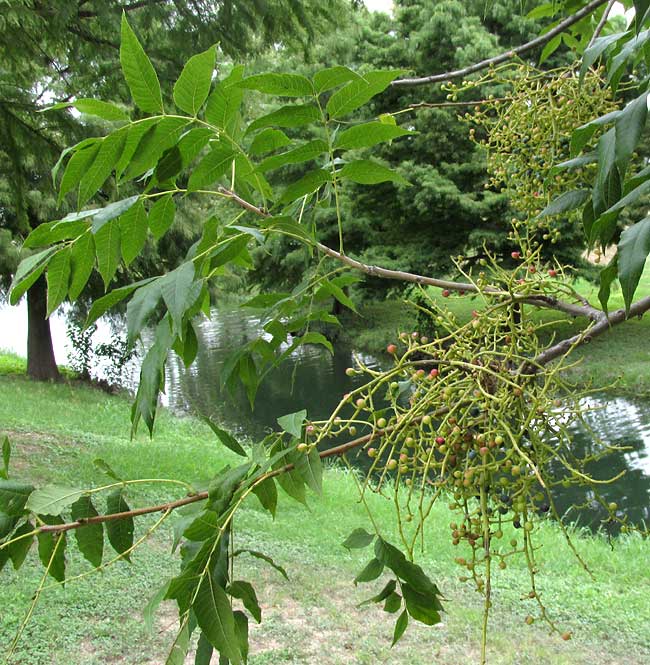
That picture shows that at this early stage, when fruits aren't nearly as large as they eventually become, already some are turning red and black, and falling off prematurely. It's a feature of their flowers' natural development that their ovaries are divided into two to four cells, each containing an ovule that will develop into a seed. As the ovaries mature into fruits, normally all but one cell aborts, leaving just one with its single ovule, and that cell matures into the tree's normal, one-seeded fruit. Seeing how these small, immature fruits are falling off, it looks as if many times all the cells abort, not just part of them.
The tree's pinnately compound leaves, which looks a lot like the locally abundant Pecan tree's similarly pinnately compound ones, are shown below:
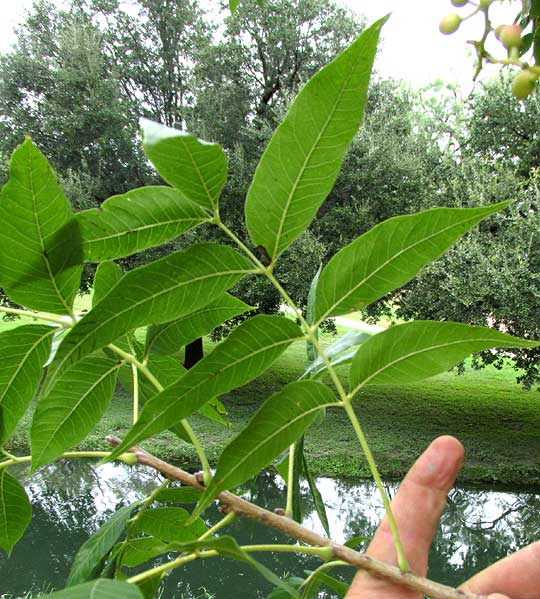
from the September 16, 2012 Newsletter issued from the valley of the Dry Frio River in northern Uvalde County, southwestern Texas, on the southern border of the Edwards Plateau; elevation ~1750m (~5750 ft); N29.62°, W99.86°; USA
SOAPBERRY FRUITING
Here and there along the Dry Frio River's limestone slopes you find smallish trees with pinnately compound leaves like those of an ash tree, except that the leaves arise only one per twig node (alternate) instead of two (opposite) as with ashes. Nowadays some of these trees are loaded with yellowish fruits, as shown below:
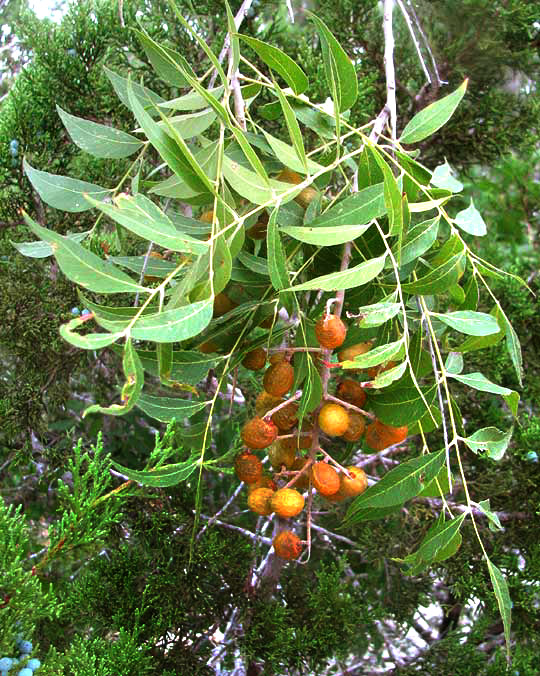
The fleshy, yellowish fruits bear single round, black, very hard seeds, as seen below:
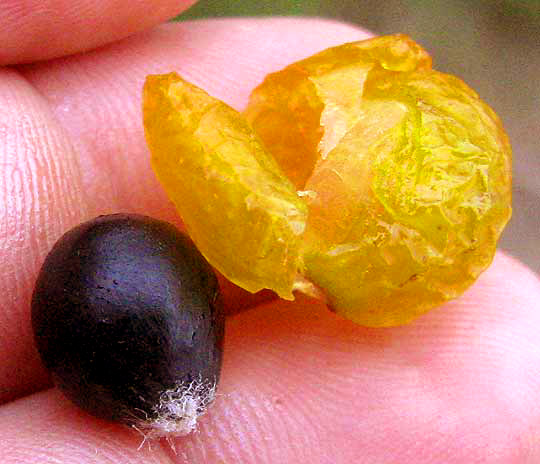
We've encountered this tree before, down in Mexico's southernmost state of Chiapas, where we got a picture of what happens when you remove the fruits' skins and beat them in a little water. That picture is shown in the section below.
So, this is the Soapberry Tree, the same species encountered in Chiapas, but it's a northern variety more specifically referred to as the Western Soapberry. It's SAPINDUS SAPONARIA var. DRUMMONDII. In older books Western Soapberries are listed as Sapindus drummondii. In the US our variety occurs from Arizona to Louisiana north to Kansas and southwestern Missouri, plus it extends into northern Mexico. In central Mexico the type variety takes over and occurs in the Caribbean, Central and South America, plus extreme southern Florida and a coastal part of Georgia.
Chiapas's Soapberries grew into substantial trees but ours here average maybe 10 to 15 feet high (3-4.5m), though I read that in well watered, rich soil they can reach 50 feet (15m). I tried to froth up a good suds the way I did for the Chiapas picture but our fruits wouldn't get so frothy. Maybe I just got them too late in the season. However, the black seeds are as black and hard as the Mexican ones.
Of course the seeds have been used for making necklaces and buttons, but I always think of what Mexican kids used to do with them -- play marbles.
from the April 21, 2008 Newsletter written in the community of 28 de Junio and issued from a ciber 8 kms to the west in
Pujiltic, Chiapas, MÉXICO
SOAPBERRY
These days a handsome tree growing about 30 feet tall with pinnately compound leaves a bit like those of Pecan trees is fruiting abundantly, and in the old days its golden-brown fruits were highly regarded. That's it below:
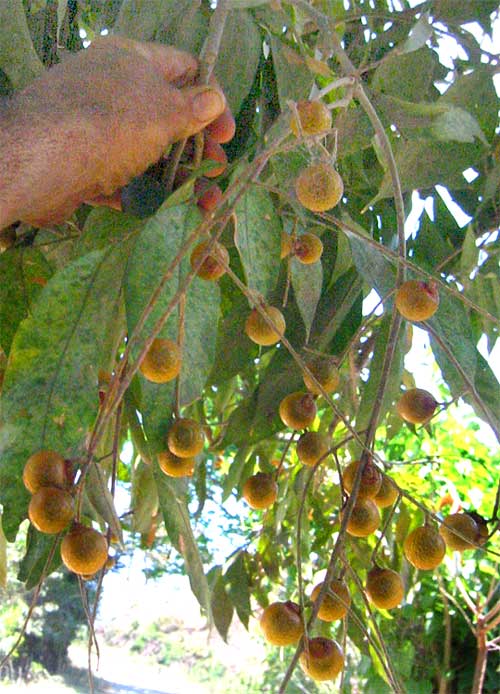
The tree is Soapberry, SAPINDUS SAPONARIA, and you can see from the Latin name that Linnaeus was thinking "soap" when he named the species. "Sap-indus" was his "Indian soap," and saponaria was just more soap. The species gives its name to its whole family, the Soapberry Family, the Sapindaceae, which also includes Litchi Trees, Goldenrain-Trees and Balloon-Vines. Here Soapberry is called Jaboncillo, jabón being "soap." To humans everyplace, this tree simply means "soap." I soaked some fruits a couple of days, squeezed them, and here you see the sudsy results.
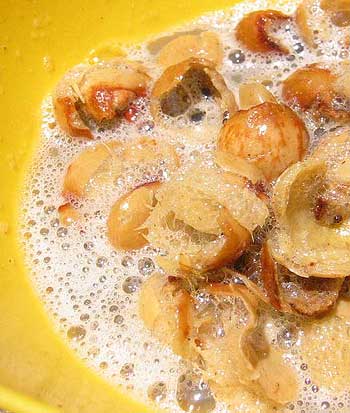
I didn't produce the sudsy water the traditional way, which they tell me is much more effective. The time-honored recipe for making soap from fruits begins with "Dry the fruits until they can't be dried any more, then the señora on her stone metate grinds and grinds until she has pure dust... " Then you use the dust pretty much as if it were laundry detergent.
Despite my half-hearted efforts, the sudsy water I got cut right through greasy, gritty stuff on my hands, and the suds seemed to last longer than equivalently sudsy water produced by commercial detergent. It even left my hands smelling a little fruity.
Since the fruits' seeds are extremely hard I've asked several people if washing clothing with homemade Soapberry powder doesn't leave little flecks of fruit and seedcoat on the clothing. People say that there's no problem, or maybe the question just doesn't register. Flecks on clothing are more of a Northern concern.
